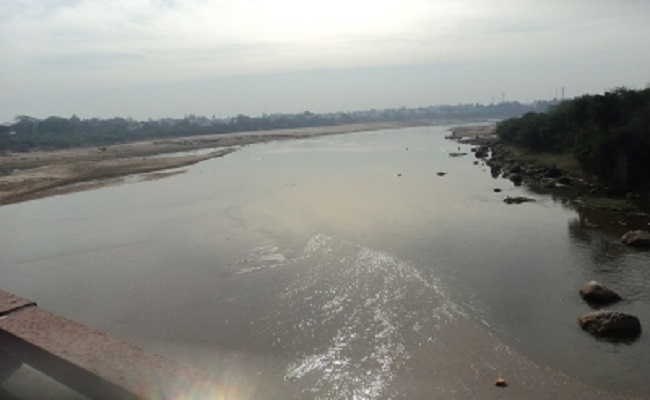
Rising sea levels, increasing ocean temperature, monsoon extremes and cyclones are the impact of climate change for the coastal areas of Andhra Pradesh.
While the long coastal line of the state in general faces the climate change issues, cities like Visakhapatnam, Kakinada and Machilipatnam are particularly vulnerable.
According to scientists, abnormality of the cyclones is the result of global warming and climate change. Visakhapatnam, the biggest city in the state and the proposed state capital, has experienced eight severe cyclonic storms since 2014.
Vizag, as the port city is also known, was battered by very severe cyclonic storm Hudhud on October 12, 2014. For the first time in modern history, the city witnessed an unparalleled natural calamity.
With wind speed of 165 kmph during landfall, Hudhud caused widespread devastation in the city and other parts of north coastal Andhra killing 60 people and uprooting thousands of trees, electricity poles and destroying the civic infrastructure. It took weeks for normalcy to be restored in the city.
Experts are of the view that huge disparity in the temperature of the land and the ocean may lead to formation of many cyclonic storms, which will have the potential to develop into very severe cyclonic storms. Strong winds and high rainfall will lead to an increase in the sea level.
The state's long coastline faces the double threat of floods and rising sea levels due to climate change.
The vulnerability was again evident in May 2020 when cyclone Amphan, strongest storm recorded in decades in Bay of Bengal, hit the coast forcing several million to evacuate
Experts say global warming has rendered monsoon erratic and extreme and is giving way to high intensity thunderstorms which will increase the possibility of flash floods and landslides.
Moreover, during thunderstorms, the rainfall is quick and high and this also increases the sea levels.
Melting of the glaciers due to global warming is also causing the sea level to rise. Different factors are likely to lead to flooding of the coastal cities and regions
According to SSVS Ramakrishna, former head of the department of oceanography and meteorology, Andhra University, global warming has resulted in a rise in ocean temperatures, the temperature in the Indian ocean has risen much quicker than expected.
As per the report of the UN's Intergovernmental Panel on Climate Change (IPCC), Visakhapatnam is one among six Indian cities that could be exposed to coastal flooding if the sea levels rise by 50 cm due to global warming.
According to the report, the city will be under 3 feet of sea water due to rising sea levels by the end of the century.
However, some experts believe that Vizag is unlikely to be submerged because of its geographic location. The city is surrounded by hilly terrain of Eastern Ghats.
While low-lying and some other areas may be under threat, hills and hillocks may protect the city from flooding.
Vizag currently has a population of more than 20 lakh and projected population growth rate of the city is 2.35 per cent per cent.
As the state government plans to make Vizag the executive capital of the state, the population is likely to grow further.
National Institute of Oceanography's regional head GPS Murthy is of the view that the rise in sea level will be gradual.
"The predictions of IPCC are based on present trends of temperature rise, CO2 release and melting of glaciers. There may be several changes by the end of the century," he said.
In the previous reports too, IPCC had sounded a warning. These reports highlighted that since climate change is bound to impact the seas, there will be an impact on coastal cities too.
Andhra Pradesh has a 974 km-long coastline and the climate change poses problems to the entire coast belt.
Some experts believe that coastal cities Machilipatnam and Kakinada are facing a bigger threat due to the very small difference between the land mass and the sea.
The Government of India released the National Action Plan on Climate Change (NAPCC) in 2008 as part of an ambitious domestic action plan to address climate change.
The NAPCC focuses on adapting to climate change and protecting the vulnerable sections of society through an inclusive and sustainable development strategy that also enhances ecological sustainability and innovation.
Most of the adaptation challenges such as coastal zone disasters, droughts, adverse effect on human health, depleting water resources, are experienced at the state level and programmes aimed at improving the adaptive ability are also undertaken and implemented at state level.
Andhra Pradesh has prepared the State Level Action Plan on Climate Change (SAPCC) to enable it to address existing and future climate risks and vulnerabilities
According to the report, major climate change issues for the state arise in the agriculture and forestry sectors and in relation to the long coastline.
Agriculture is severely affected by variability in rainfall and temperature patterns, while rising sea levels and extreme events of marine origin, such as cyclones, pose problems for the coastal areas.
Besides these, other critical areas of concern are food security, increasing number of climate vulnerable habitats (like slums or village dwellings) and climate vulnerable infrastructure (like roads and bridges which may be washed away by floods).














